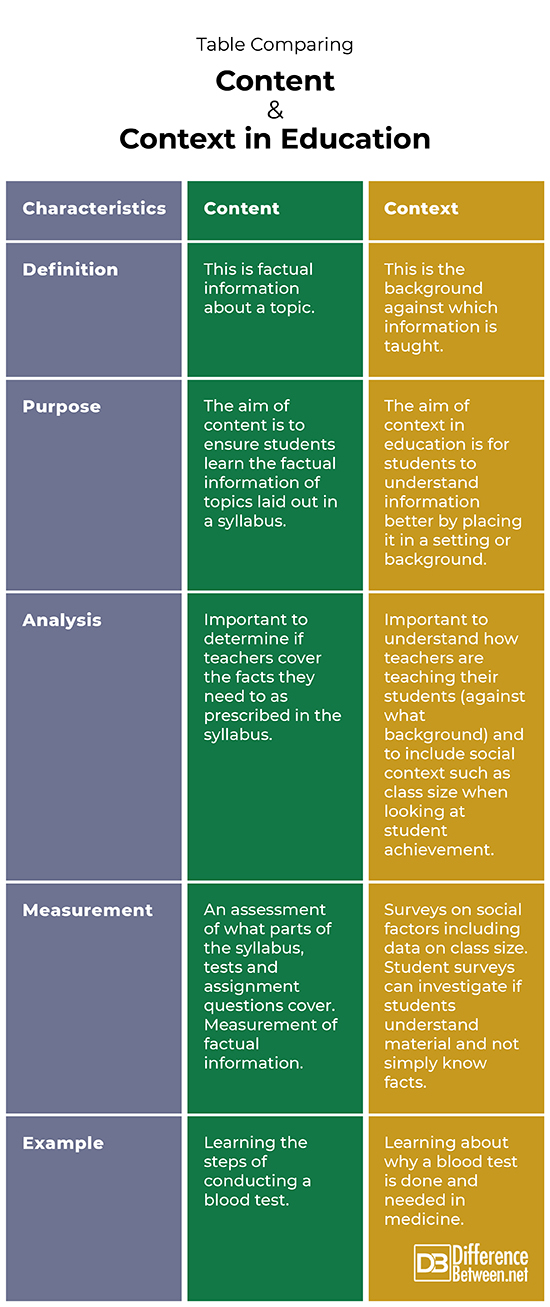Difference Between Content and Context in Education
Content is the facts of a topic while context is the background against which such information is imparted to students.

What is Content?
Definition:
Content is the information that is written about a particular subject. These are the facts that are taught in a classroom.
Purpose:
The facts included in a written work are provided to inform the reader. For instance, information in a textbook educates learners about a particular topic.
Examples:
In an education setting, the content will be dictated by the syllabus which lists the topics that need to be covered along with objectives about what students need to know. For example, a biology syllabus may state that students need to know the facts regarding how a blood test is done. Students then learn the steps of how a blood test is conducted.

What is Context?
Definition:
Context is the background or setting of something that impacts how people understand the information.
Purpose:
The idea behind context is that it helps students to understand the relevance and significance of the information they learn. The educational context also includes the social context. In fact, factors such as how many students are in a classroom impact student achievement, so class size is also an important context to consider when researching education and student success.
Examples:
The application of information that is taught is an example of context. For instance, students will learn why a blood test is done and how this is helpful in medicine. Other factors such as class size and what resources students have available to use are also examples of context in education, specifically in terms of student achievement.
Difference between Content and Context in education?
Definition
Content is the facts about a certain topic. Context is the background against which information is taught.
Purpose
The aim of the content is for students to learn facts as required by the syllabus. The aim of context is to facilitate the understanding of information by placing it in an appropriate setting.
Analysis
Analysis of content ensures that students are taught what is required by a syllabus. Analysis of context allows researchers to determine if students are understanding the information and also what social context is involved in student achievement.
Measurement
Measuring content is by tests and other assessments on what information students know on a specific topic. Measuring context involves surveys, including surveys on the social context that asks questions about class size, student diversity, and so on.
Example
An example of content would be students learning the steps of how to test a blood sample. An example of context would be students learning why a blood test is important in medicine.
Table comparing Content and Context in education

Summary of Content Vs. Context in education
- Both content and context are important in the field of education.
- Content is a focus on the facts and information that is taught to students.
- Context is the background against which facts are taught.
- Social context in education refers to factors such as class size, which inevitably influences student achievement and success.
FAQ
What is context and content analysis?
Content analysis is the study and analysis of information and facts being taught, while contextual analysis is the context or background against which information and facts are taught.
What is the difference between context and subject?
Context is the background against which information is taught, including how you can use and apply the knowledge that is learned. The subject is a topic, for instance, biology or physics, about which students learn information.
What is an example of a context?
A teacher could talk about blood pressure and then describe to students in a health class how such measurements are used in real life and why they are important.
What is the example of content?
Content is the factual information about a particular topic or theme. For example, learning what types of animals are found living in North America in a class on Zoology.
Why is context important in education?
Context is significant as a factor in influencing student achievement. Class size and teaching methods are important but so is emphasizing how students can apply what they have learned.
What is a classroom context?
This is how a teacher is able to control and manage the classroom while teaching. It can include parameters such as diversity of learners and class size.
What is knowledge educational context?
This includes understanding the context in which teachers teach students. In other words, what students are being taught, how many students are being taught, and which grades and curricula are being taught.
- Difference Between Rumination and Regurgitation - June 13, 2024
- Difference Between Pyelectasis and Hydronephrosis - June 4, 2024
- Difference Between Cellulitis and Erysipelas - June 1, 2024
Search DifferenceBetween.net :
References :
[0]Columbia University Mailman School of Public Health. “Content analysis”. Columbia University, 2019, https://www.publichealth.columbia.edu/research/population-health-methods/content-analysis
[1]Esongo, Njie Martin. "Correlation between the Availability of Resources and Efficiency of the School System within the Framework of the Implementation of Competency-Based Teaching Approaches in Cameroon." Journal of Education and Practice 8.2 (2017): 82-92.
[2]Sanders, William L., S. Paul Wright, and Sandra P. Horn. "Teacher and classroom context effects on student achievement: Implications for teacher evaluation." Journal of personnel evaluation in education 11.1 (1997): 57-67.
